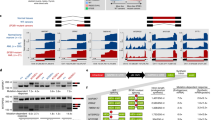Abstract
An eGFP-intron splicing system that allows for co-ordinated expression of up to four siRNAs from a single adenoviral vector has been developed. In this splicing structure the intron, embedded by a multiple miR30-based shRNAs, is located between two incomplete eGFP domains which require successful splicing for functionality. To prove the principle of the method, an adenoviral vector delivering four transcripts targeting survivin, XIAP, Hec1, and VEGF was developed which enabled the knockdown of target genes by 70, 70, 54 and 44%, respectively, in HeLa cells. This is the first report of multi-siRNA engineering technology in the context of adenoviral vector which would enable concomitant knockdown of tumor-related target genes. The results provide a strategy for gene function analysis and cancer gene therapy.



Similar content being viewed by others
References
Asanuma H, Torigoe T, Kamiguchi K et al (2005) Survivin expression is regulated by coexpression of human epidermal growth factor receptor 2 and epidermal growth factor receptor via phosphatidylinositol 3-kinase/AKT signaling pathway in breast cancer cells. Cancer Res 65(23):11018–11025
Cai X, Hagedorn CH, Cullen BR (2004) Human microRNAs are processed from capped, polyadenylated transcripts that can also function as mRNAs. RNA 10(12):1957–1966
Cheng SY, Huang HJ, Nagane M et al (1996) Suppression of glioblastoma angiogenicity and tumorigenicity by inhibition of endogenous expression of vascular endothelial growth factor. Proc Natl Acad Sci USA 93(16):8502–8507
Chung KH, Hart CC, Al-Bassam S et al (2006) Polycistronic RNA polymerase II expression vectors for RNA interference based on BIC/miR-155. Nucleic Acids Res 34(7):e53
Greber D, Fussenegger M (2007) Multi-gene engineering: simultaneous expression and knockdown of six genes off a single platform. Biotechnol Bioeng 96(5):821–834
Hannon G, Rossi J (2004) Unlocking the potential of the human genome with RNA interference. Nature 431(7006):371–378
Hu T, Chen P, Fu Q et al (2010) Comparative studies of various artificial microRNA expression vectors for RNAi in mammalian cells. Mol Biotechnol 46(1):34–40
Jackson AL, Bartz SR, Schelter J et al (2003) Expression profiling reveals off-target gene regulation by RNAi. Nat Biotechnol 21(6):635–637
Kawasaki H, Taira K (2003) Short hairpin type of dsRNAs that are controlled by tRNA(Val) promoter significantly induce RNAi-mediated gene silencing in the cytoplasm of human cells. Nucleic Acids Res 31(2):700–707
Martin-Lluesma S, Stucke VM, Nigg EA (2002) Role of Hec1 in spindle checkpoint signaling and kinetochore recruitment of Mad1/Mad2. Science 297(5590):2267–2270
Masiero M, Nardo G, Indraccolo S et al (2007) RNA interference: implications for cancer treatment. Mol Aspects Med 28(1):143–166
Papadakis ED, Nicklin SA, Baker AH et al (2004) Promoters and control elements: designing expression cassettes for gene therapy. Curr Gene Ther 4(1):89–113
Pei DS, Di JH, Chen FF et al (2010) Oncolytic-adenovirus-expressed RNA interference for cancer therapy. Expert Opin Biol Ther 10(9):1331–1341
Vorburger SA, Hunt KK (2002) Adenoviral gene therapy. Oncologist 7(1):46–59
Xia H, Mao Q, Paulson HL et al (2002) siRNA-mediated gene silencing in vitro and in vivo. Nat Biotechnol 20(10):1006–1010
Zeng Y, Cai X, Cullen BR (2005) Use of RNA polymerase II to transcribe artificial microRNAs. Methods Enzymol 392(1):371–380
Zhou H, Xia XG, Xu Z (2005) An RNA polymerase II construct synthesizes short-hairpin RNA with a quantitative indicator and mediates highly efficient RNAi. Nucleic Acids Res 33(6):e62
Zhu X, Santat LA, Chang MS (2007) A versatile approach to multiple gene RNA interference using microRNA-based short hairpin RNAs. BMC Mol Biol 8:98
Acknowledgments
This work was supported by the “Foundation for Excellent Doctor Degree Dissertation” (S2009YB04) of Shaanxi Normal University and research grants to H.X from National Natural Science Foundation of China (No. 30872993 and No. 31070137).
Author information
Authors and Affiliations
Corresponding author
Rights and permissions
About this article
Cite this article
Li, X., Liu, S., Wang, D. et al. Adenoviral delivered eGFP-intron splicing system for multiple gene RNAi. Biotechnol Lett 33, 1723–1728 (2011). https://doi.org/10.1007/s10529-011-0633-5
Received:
Accepted:
Published:
Issue Date:
DOI: https://doi.org/10.1007/s10529-011-0633-5




